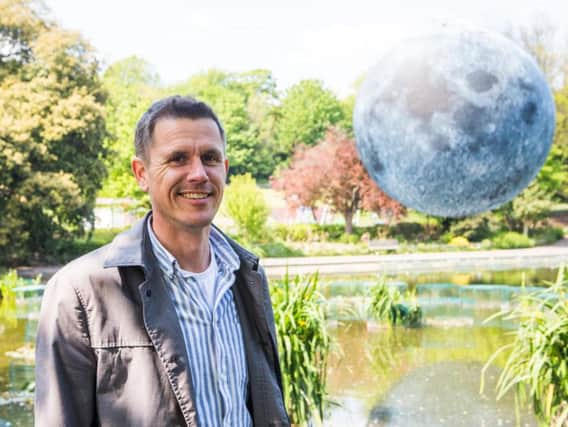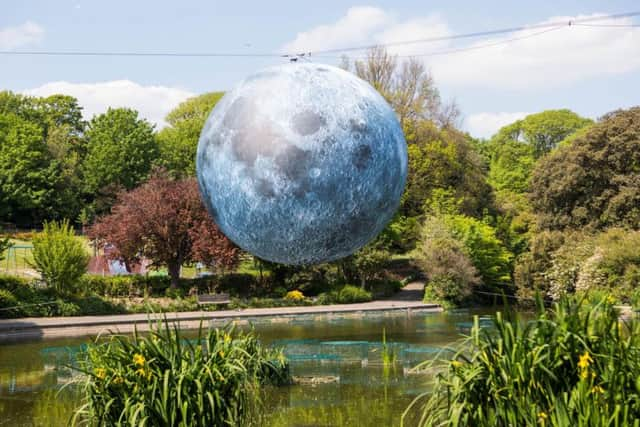Take a trip to the moon at unique Brighton Festival event


The free arts event is part of the Brighton Festival, and will see lunar imagery, moonlight and surround sound composition by award-winning composer Dan Jones.
Visitors are invited 'to explore the surface with your family, enjoy a lunar picnic or serenade a lover' underneath the moonlight.
Advertisement
Hide AdAdvertisement
Hide Ad

Here's what creator Luke Jerram had to say about his unique installation.
Where did you get the idea to make an artwork such as Museum of the Moon?
Bristol has the highest tidal range in Europe. There’s a 13m gap between high tide and low tide. Cycling to work each day over the river to work, reminded me that it’s the gravitational pull of the Moon that’s making this happen. I had the idea to create the Museum of the Moon some 15 years ago, but it was only until very recently that the data for creating the Moon imagery was made available by NASA.
Advertisement
Hide AdAdvertisement
Hide AdAs a child I always wanted a telescope so I could study the Moon and the night’s sky. Now with my own Moon, I can fly there, study every detail and share this experience with the public. We can explore the far side of the Moon which is never visible from Earth
The moon has always been an inspiration for artists. What was so inspiring for you about the moon?
From the beginning of human history, the moon has acted as a ‘cultural mirror’ to our beliefs, understanding and ways of seeing. Over the centuries, the moon has been interpreted as a god and as a planet. It has been used as a timekeeper, calendar and to aid night time navigation. Throughout history the moon has inspired artists, poets, scientists, writers and musicians the world over. The ethereal blue light cast by a full moon, the delicate crescent following the setting sun, or the mysterious dark side of the moon has evoked passion and exploration. Different cultures around the world have their own historical, cultural, scientific and religious relationships to the moon.
Museum of the Moon allows us to observe and contemplate cultural similarities and differences around the world, and consider the latest moon science. Depending on where the artwork is presented, its meaning and interpretation will shift. Through local research at each location of the artwork, new stories and meanings will be collected and compared from one presentation to the next.
Advertisement
Hide AdAdvertisement
Hide AdDuring its tour, the Moon has always be shown in public spaces. Why is it important to you to show your artworks in public spaces?
Depending on where the artwork is presented, the meaning and interpretation of the Museum of the Moon, will shift. The interpretation of the Moon will be completely different if it is presented in a cathedral, warehouse, science museum or arts centre.
Whether the artwork is exhibited in China, USA, India or Europe the cultural context and audience, also effects the public’s interpretation. Every culture has its own relationship to the Moon which varies from one country to another.
Museum of the Moon is made of really precise lunar imagery from NASA. Can you explain this choice?
Advertisement
Hide AdAdvertisement
Hide AdI wanted to make the artwork seem as authentic and realistic as possible to give the public the opportunity to fly to the Moon. For most people, this will be their most intimate, personal and closest encounter they will ever have with the Moon.
What do you expect to provoke among the public with Museum of the Moon?
It’s been wonderful to witness the publics’ response to the artwork. Many people spend hours with the Moon exploring its every detail. Some visitors lie down and moon-bathe.
In Marseille I arranged an arc of deckchair beneath the Moon. Within minutes, many of the chairs had been groups into pairs and were occupied by couples holding hands!
Advertisement
Hide AdAdvertisement
Hide AdIn Bristol, we had an unexpected group of visitors who arrived in slow motion to the exhibition, dressed as spacemen!
Each venue that hosted the Moon had its own architectural specificities. It also offered different performances beneath the Moon. Therefore it is always a new story. Why is it important to you to have several performances going on beneath your Moon?
The Museum of the Moon is an installation artwork that combines the architecture of the space, the sculpture of the Moon and a surround sound composition. Each venue and host, has the opportunity to curate their own moon-inspired events which reflect their local culture and creativity.
Like many of my artworks like Play Me, I’m Yours and Withdrawn, this work provides opportunities for collaboration and the creative input of others.
Advertisement
Hide AdAdvertisement
Hide AdMusic is also very important for your artwork. How relevant and important is Dan Jones’ composition to your work?
The Museum of the Moon installation is a fusion of lunar imagery, moonlight and surround sound composition. As the artwork tours, new audio compositions will be created and performed by a range of established composers and musicians, so adding to the Museum of the Moon collection.
To find out more, visit: https://brightonfestival.org/event/17448/museum_of_the_moon/